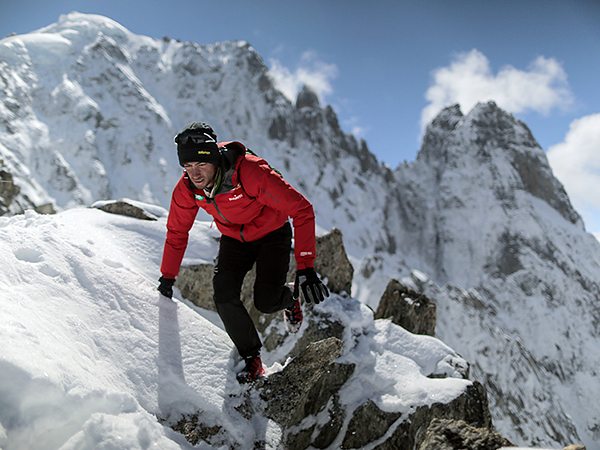The Future of Alpinism Combines Running and Cranking

The following story was written by B.C.-based alpinist Ian Welsted and first appeared in the 2015 October/November issue of Gripped magazine.
Reiner Thoni, Canada’s most successful ski mountaineering racer, has recently turned his attention to alpine climbing, making an attempt on the notorious Hummingbird Ridge of Mount Logan. How could a relative unknown in climbing circles come out of nowhere to attempt the most difficult standing problem in North American alpinism? Reiner is an example of a growing trend in mountaineering.
There is a whole new category of mountain pursuit that is taking Europe by storm, fastest known time (FKT). A long history of training makes Reiner the perfect candidate for the Hummingbird, just as Jornet, more known as a runner, is breaking speed records on a number of the world’s highest mountains. Rock climbing grades skyrocketed in the 1980s when specific training tools, such as the hangboard, came on the scene. Similarly, with decades of training these FKT athletes are seeing success in the mountains.
Reiner is the most obvious Canadian example of an athlete who is using his aerobic background to pursue alpine climbing. Born in Jasper to a ski guide father, he has decades of ski touring to build his base fitness level. This background culminated in winning the Canadian Ski Mountaineering (skimo) Championships from 2009 through 2013 and the North American Championships 2011-2012. He was the first Canadian to finish top 15 in the European skimo racing arena, where the sport is much more competitive.
Reiner has said the best advice he ever received from a co-competitor is that “getting to your true peak does not come from simply training hard but from at least a decade of training smart and building year after year.” Turning his attention to alpine climbing, he has climbed the Wishbone Arete and the North Face on Robson and the Japanese Route on Mount Alberta. He has summited Robson eight times and established a new normal approach to the mountain which is being widely called the Thoni approach. Check out the video of Reiner skiing off the summit on very narrow racing skis if you are still unimpressed.
If decades of training seem too much effort to get into the big mountain alpine game think of this comparison. There is a new generation of rock climbers, such as Adam Ondra and Alex Megos, who grew up with climbing gyms and are climbing ever harder routes by their teens. This is because they have a decade of climbing specific training behind them. Climbers initially only climbed and didn’t train.
This changed most obviously in the 1980s with Wolfgang Gullich’s invention of the campus board and Ben Moon’s systems training. In 12 years the world’s cutting edge grade went from 5.13 to 5.14d. In the language of sport physiology this is because of a program of deliberate practice.
Alpinism at a high level demands this deliberate practice. Steve House’s latest book, Training for the New Alpinism, reflects this. As House states, “As soon as alpinists have time and access to the mountains they stop training because they can go climbing instead. This is the wrong approach… and has contributed to the dead-end standards of alpine climbing.”
There are very obvious examples of the advancement of grades, such as in dry-tooling. This confirms the need for training, as dry-tooling has advanced through specific training. Also there are highly visible athletes who have broken this mold, most notably Ueli Steck who trains at an Olympic level.
The lack of concerted training by alpinists is not true of FKT athletes, most of whom come from an aerobic sports background and then transfer their fitness to climbing. The most well-known, Kilian Jornet, grew up in a mountain hut and ran and cross country skied for recreation throughout childhood. At nine he traversed the Pyrenees over 42 days with his parents.
At the age of 13 he joined a centre for ski racing and began formal training. So by the time he was winning world championships he had, you guessed it, a decade of training. Karl Egloff, who beat Jornet’s FKT record on Aconcagua by an amazing 10 per cent, had climbed 30 6,000-metre peaks by the age of 15.
A huge part of alpinism goes beyond training and involves mountain survival skills. For Reiner there was no climbing gym when he was growing up, but this didn’t stop him. As he says, “One part of preparation for alpine climbing is technical aspects which can be practiced in a gym or at a crag. The other is physical and mental adaptations that come with moving in the mountains.”
House recommends ski mountaineering, “It is weight bearing and mimics the environment and motions of mountaineering.” For Reiner, taking on the Hummingbird, notoriously dangerous after being the site of Dave Cheesemond’s death, is easier as he has spent years traveling light and fast through the biggest mountains the Rockies have to offer.
Why write about a ski mountaineer in a climbing magazine? It comes down to this. In the Canadian Rockies it is a running joke that there are only a dozen people who go alpine climbing. Yet every summer there is a crop of youth who climb super hard in the gym and seem eager to get out in the mountains.
What Reiner’s history shows is that if you want to be successful alpine climbing one of the prime requirements is mileage and lots of it. If you have aspirations to climb mountains, then as well as heading to the rock gym you should join the running club or better yet the Nordic ski team.
Starting at the gym at a young age builds the base strength needed for the modern era’s hard grades. Combined with aerobic exercise and experience in the mountains, we’ll see a new cranking generation of alpinists.


